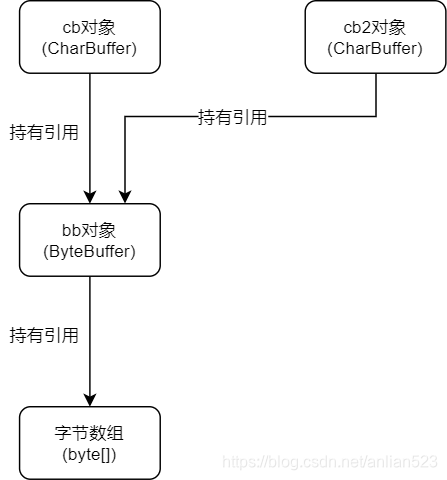从String获得ByteBuffer、从ByteBuffer获得CharBuffer的正确姿势
文章目录
错误示例
import java.nio.ByteBuffer;
import java.nio.CharBuffer;
public class test2 {
public static void main(String[] args) {
ByteBuffer bb = ByteBuffer.wrap("Some text".getBytes());
CharBuffer cb = bb.asCharBuffer();
String s = cb.toString();
System.out.print(s);
}
}

此时打印字符串乱码。
错误原因
"Some text".getBytes()获得字符串对应的字节(这些字节是字符集中——字符对应的若干字节)是通过UTF-8字符集(默认的字符集)来获得的。
//String.java
public byte[] getBytes() {
return StringCoding.encode(value, 0, value.length);//调用到StringCoding的encode函数
}
//StringCoding.java
static byte[] encode(char[] ca, int off, int len) {
String csn = Charset.defaultCharset().name();//这句会获得默认的字符集
try {
// use charset name encode() variant which provides caching.
return encode(csn, ca, off, len);
} catch (UnsupportedEncodingException x) {
warnUnsupportedCharset(csn);
}
try {
return encode("ISO-8859-1", ca, off, len);
} catch (UnsupportedEncodingException x) {
// If this code is hit during VM initialization, MessageUtils is
// the only way we will be able to get any kind of error message.
MessageUtils.err("ISO-8859-1 charset not available: "
+ x.toString());
// If we can not find ISO-8859-1 (a required encoding) then things
// are seriously wrong with the installation.
System.exit(1);
return null;
}
}
//Charset.java
public static Charset defaultCharset() {
if (defaultCharset == null) {
synchronized (Charset.class) {
String csn = AccessController.doPrivileged(
new GetPropertyAction("file.encoding"));//注意这里
Charset cs = lookup(csn);
if (cs != null)
defaultCharset = cs;
else
defaultCharset = forName("UTF-8");
}
}
return defaultCharset;
}
看来最终是从"file.encoding"(文件的编码方式一般也都是UTF-8)获得的默认字符集,如果不支持该字符集(if (cs == null)),才会设置默认字符集为"UTF-8"。
cb.toString()时,认为cb对象持有的ByteBuffer成员的字节数组都是UTF-16字符集转换而来的字节,同时它又利用了当Unicode码<0x10000时,UTF-16字符集对应字节与Unicode码一样。而java的char类型就是使用二字节长度的Unicode码作为底层存储,所以执行cb.toString()时,就是把每两个字节作为一个char来进行的转换。具体分析过程在本人博客Java源码分析 ByteBuffer.asCharBuffer打印字符串乱码原因的从源码分析章节。- 这样,
"Some text".getBytes()encode编码时用的是UTF-8字符集把每个字符变成了若干字节; String s = cb.toString()decode解码时用的是UTF-16字符集把若干字节变成了每个字符。自然就会出错。
Unicode与UTF-8与UTF-16
- Unicode只是字符集合,虽然它为每个字符分配了一个唯一的编号,但是它却不能作为存储的标准,即它不能称为一个CharSet字符集。Unicode的编码空间为U+0000到U+10FFFF。
- java的char类型变量,其底层存储实际为U+0000到U+FFFF的Unicode码。因为char只有两个字节。
- UTF-8以字节为单位对Unicode进行编码。从下表的分析可见,从Unicode转换为UTF-8 字节流实际上就是把Unicode的有效bit依次放入UTF-8 字节流中的x。从字符的第一个字节,能够知道当前字符一共用几个字节来存储。
| Unicode编码(十六进制) | UTF-8 字节流(二进制) | 分析 |
|---|---|---|
| 000000-00007F | 0xxxxxxx | 0x7F从右开始有7个有效bit,所以有7个x |
| 000080-0007FF | 110xxxxx 10xxxxxx | 0x7FF从右开始有11个有效bit,所以有11个x |
| 000800-00FFFF | 1110xxxx 10xxxxxx 10xxxxxx | 0xFFFF从右开始有16个有效bit,所以有16个x |
| 010000-10FFFF | 11110xxx 10xxxxxx 10xxxxxx 10xxxxxx | 0x10FFFF从右开始有21个有效bit,所以有21个x |
- UTF-16以16位无符号整数(二字节)为单位对Unicode进行编码。为了区分下表两种情况,第一行情况的编码肯定不会以
ob110110或0b110111开头。
| Unicode编码(十六进制) | UTF-16 字节流(二进制) | 分析 |
|---|---|---|
| 000000-00FFFF | Unicode编码本身(一个16位整数) | |
| 010000-10FFFF | 110110yyyyyyyyyy 110111xxxxxxxxxx (两个16位整数) (即使是最大值0x10FFFF,减去0x010000后为0xFFFFF) |
0xFFFFF从右开始有20个有效bit,依次对应前面10个y和后面10个xy或x与前面的固定bit各组成一个16位整数 |
正确使用方法
调用String.getBytes的无参数版本
import java.nio.ByteBuffer;
import java.nio.CharBuffer;
import java.nio.charset.Charset;
public class test2 {
public static void main(String[] args) {
ByteBuffer bb = ByteBuffer.wrap("Some text".getBytes());
String encoding = System.getProperty("file.encoding");
CharBuffer cb = Charset.forName(encoding).decode(bb);//通过特定字符集的decode函数来获得CharBuffer
String s = cb.toString();
System.out.print(s);
}
}
/*output:
Some text
*/
- 之前讲了,getBytes的无参数版本会使用
"file.encoding"的字符集进行encode。 - 所以decode时,也使用
"file.encoding"的字符集来进行decode。 - 综上,可以得到正确结果。
调用String.getBytes的有参数版本
import java.io.UnsupportedEncodingException;
import java.nio.ByteBuffer;
import java.nio.CharBuffer;
public class test2 {
public static void main(String[] args) throws UnsupportedEncodingException {
ByteBuffer bb = ByteBuffer.wrap("Some text".getBytes("UTF-16BE"));
CharBuffer cb = bb.asCharBuffer();
String s = cb.toString();
System.out.print(s);
}
}
/*output:
Some text
*/
- getBytes的有参数版本,encode时指定了
"UTF-16BE"这个字符集,BE代表big-endian大端。 bb.asCharBuffer()默认返回了一个大端的CharBuffer。cb.toString()构造字符串时,以每两个字节作为一个Unicode码。又由于两字节的Unicode码和UTF-16的字节流一样,所以直接使用UTF-16的两个字节就相当于使用Unicode码。- 综上,可以得到正确结果。
调用ByteBufferAsCharBufferB实例的put方法
import java.nio.ByteBuffer;
import java.nio.CharBuffer;
public class test2 {
public static void main(String[] args) {
ByteBuffer bb = ByteBuffer.allocate(24);//需要分配地足够大
CharBuffer cb = bb.asCharBuffer().put("Some text");
cb.flip();
String s = cb.toString();
System.out.println(s);
CharBuffer cb2 = bb.asCharBuffer();
String s2 = cb2.toString();
System.out.println(s2);
}
}
/*output:
Some text
Some text
*/

ByteBuffer.allocate(24)。只是给字节数组分配大小,值都是默认值。CharBuffer cb = bb.asCharBuffer().put("Some text")。cb对象持有一个bb对象,调用put时,使用Unicode码的两个字节,和默认的大小端模式(默认大端),来向bb对象里依次放置各个字节。- 调用put后,position成员已经变成9了,如果没有这句
cb.flip(),那么position不能归零,会使得调用toString方法时不会从头开始读取。 - cb2对象也能打印出同样的字符串,这说明调用put,改变了bb对象的底层存储。
总结
- 第一种方法里,cb对象是一个HeapCharBuffer实例;第二、第三种方法里,cb对象是一个ByteBufferAsCharBufferB实例。
- 打印HeapCharBuffer实例时,依靠的是
char[] hb成员(继承自CharBuffer);打印ByteBufferAsCharBufferB实例时,依靠的是ByteBuffer bb成员(来自自身的类定义)。




